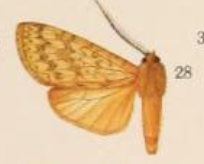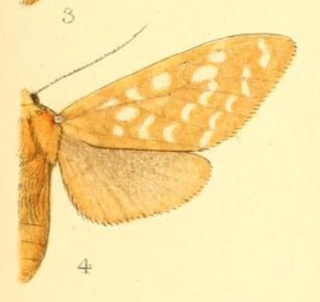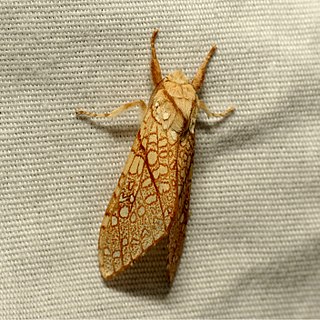
Hypena is a genus of moths in the family Erebidae. It was first described by Franz von Paula Schrank in 1802. These non-migratory moths overwinter as pupae and almost never estivate as adults.

Lophocampa is a genus of moths in the family Erebidae. The genus was erected by Thaddeus William Harris in 1841. It contains around 75 species.

Lophocampa argentata, the silver-spotted tiger moth, is a species of moth in the family Erebidae. It was described by Packard in 1864. It is found from British Columbia to southern California, and east to Arizona, Nevada, New Mexico, Colorado, Utah, Wyoming and possibly to northern Mexico.

Spilosoma is a genus of moths in the family Erebidae originally described by John Curtis in 1825. A very heterogeneous group, it is in need of review by the scientific community, as certain species probably need reclassification into their own genera.

Ugia is a genus of moths in the family Erebidae erected by Francis Walker in 1858.

Enispa is a genus of moths of the family Erebidae. The genus was erected by Francis Walker in 1866.

Melipotis is a genus of moths in the family Erebidae first described by Jacob Hübner in 1818.

Lophocampa distincta, is a moth of the family Erebidae. It was described by Walter Rothschild in 1910. It is found in Peru, Brazil, Argentina, Colombia and Ecuador.

Lophocampa alsus is a moth of the family Erebidae. It was described by Pieter Cramer in 1777. It is found in Suriname and possibly Colombia and Venezuela.

Lophocampa annulosa, the Santa Ana tussock moth, is a moth of the family Erebidae. It was described by Francis Walker in 1855. It is found in the south-western US, Mexico, Costa Rica, Ecuador, Venezuela, Peru, Suriname, Brazil, Argentina and Trinidad.
Lophocampa arpi is a moth of the family Erebidae. It was described by Paul Dognin in 1923. It is found in Brazil.

Lophocampa atomosa is a moth of the family Erebidae. It was described by Francis Walker in 1855. It is found on Jamaica and Cuba and in Ecuador.

Lophocampa bicolor is a moth of the family Erebidae. It was described by Francis Walker in 1855. It is found in Mexico and Big Bend National Park, Texas.
Lophocampa indistincta is a moth of the family Erebidae. It was described by William Barnes and James Halliday McDunnough in 1910. It is found in California, where it is only found on the Channel Islands.

Lophocampa luxa is a moth of the subfamily Arctiinae. It was described by Augustus Radcliffe Grote in 1866. It is found on Cuba.

Lophocampa maroniensis is a moth of the family Erebidae. It was described by William Schaus in 1905. It is found in Costa Rica, Panama, French Guiana and Venezuela.

Lophocampa mixta is a moth of the family Erebidae. It was described by Berthold Neumoegen in 1882. It is found in the United States in Arizona, Texas
Lophocampa niveigutta is a moth of the family Erebidae. It was described by Francis Walker in 1856. It is found in Brazil and Colombia.

Lophocampa sobrina is a moth of the family Erebidae. It was described by Stretch in 1872. It is found in California, United States.

















